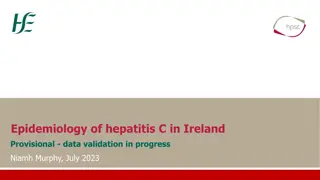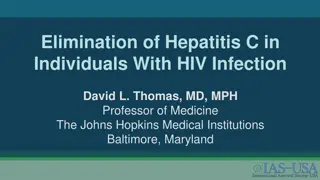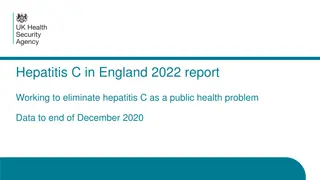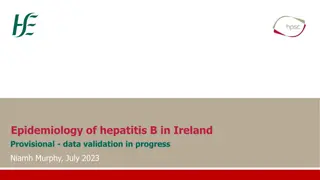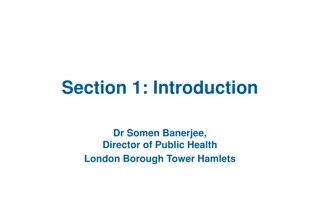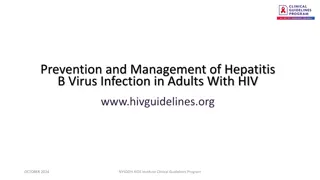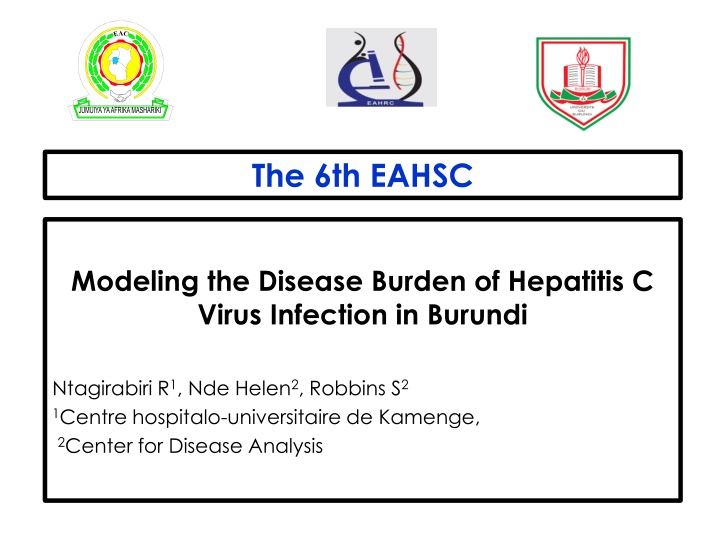
Modeling Hepatitis C Disease Burden in Burundi
Explore the modeling of the disease burden of Hepatitis C virus infection in Burundi, highlighting the global prevalence, impact on liver-related morbidity and mortality, and the lack of data on disease burden in the country. The study aims to quantify the disease burden from 2015 to 2030 using an Excel-based disease progression model based on validated assumptions from published literature.
Download Presentation

Please find below an Image/Link to download the presentation.
The content on the website is provided AS IS for your information and personal use only. It may not be sold, licensed, or shared on other websites without obtaining consent from the author. If you encounter any issues during the download, it is possible that the publisher has removed the file from their server.
You are allowed to download the files provided on this website for personal or commercial use, subject to the condition that they are used lawfully. All files are the property of their respective owners.
The content on the website is provided AS IS for your information and personal use only. It may not be sold, licensed, or shared on other websites without obtaining consent from the author.
E N D
Presentation Transcript
The 6th EAHSC Modeling the Disease Burden of Hepatitis C Virus Infection in Burundi Ntagirabiri R1, Nde Helen2, Robbins S2 1Centre hospitalo-universitaire de Kamenge, 2Center for Disease Analysis
Global Burden of Hepatitis C Hepatitis C virus (HCV) is leading cause of liver related morbidity, such as cirrhosis and hepatocellular carcinoma (HCC), as well as liver transplantation and liver-related death worldwide The HCV disease burden continues to increase as the infected population advances to late stage liver disease1 The global prevalence of viremic HCV is estimated to be 1.0% (95% CI 0.8 1.1) in 2015, corresponding to 71.1 million (62.5 79.4) viremic infections1 The Polaris Observatory HCV Collaborators. Global prevalence and genotype distribution of hepatitis C virus infection in 2015: a modelling study. Lancet Gastroenterology and Hepatology 2016; 2(3): 161-176.
Global Prevalence of HCV The Lancet. Global prevalence and genotype distribution of hepatitis C virus infection in 2015: a modelling study. Lancet Gastroenterology and Hepatology 2016; 2(3): 161-176.
Hepatitis C Disease Burden in Africa There were an estimated 10 million viremic infections in Africa in 20151 In Sub-Saharan Africa, East, there is an estimated viremic prevalence of 0.5% (95% CI 0.4-0.7) or 2.1 (1.6 2.9) million infections1 In Burundi, anti-HCV prevalence has been estimated to be around 8% in adults2 Currently, there is little data to quantify the HCV disease burden in the country and its impact on late stage liver disease We aimed to quantify the HCV disease burden in Burundi from 2015-2030 -1The Polaris Observatory HCV Collaborators. Global prevalence and genotype distribution of hepatitis C virus infection in 2015: a modelling study. Lancet Gastroenterology and Hepatology 2016; 2(3): 161-176. -2Ntagirabiri, R., Baransaka, E., Ndayiragije, A., et al. Prevalence of hepatitis C virus in Burundi: a nationwide survey. J Afr Hepatol. Gastroenterol. 2014; 8:25-28
METHODS An Excel-based disease progression model was developed to estimate HCV prevalence, incidence, and liver related morbidity and mortality in Burundi Assumptions and transition probabilities of the model are based upon published literature and have been validated The outcomes of the analysis are from a base case scenario, in which the current treatment paradigm was extrapolated through year 2030. 5
Methodology Continued Model Characteristics: Model Inputs: Excel-based model Annual population (1950 2050) Mortality rates (1950 2050) Anti-HCV prevalence Viremic rate Genotype distribution Age and gender distribution Annual and newly diagnosed Annual number treated Liver transplants attributable to HCV Risk factors (blood transfusion and injection drug use) SVR rates Transparent All formulas are unprotected and visible Ties to historical data Published data is used to calibrate the model up to 2015 Measures the impact of future decisions Interface to input potential strategies Dynamic Accounts for multiple interconnected disease stages
RESULTS There were an estimated 407,000 total viremic infections in 2015 Approximately 40% of the total infected population was aged 20 to 39 HCV Prevalence by Age and Gender Burundi, 2002 HCV Infected Population by Age Group Burundi, 2015 35.0% 60,000 Reported Prevalence 30.0% 50,000 Viremic Cases 25.0% 20.0% 40,000 15.0% 30,000 10.0% 5.0% 20,000 0.0% 10,000 - Male Female
Viremic Infections Due to continued treatment of patients, HCV infections are assumed to decrease slightly The number of total infections is expected to decline by 10% by 2030 Total Infected 500,000 400,000 300,000 200,000 100,000 -
Liver Related Morbidity Liver related morbidity is expected to increase as the infected population progresses to late stage liver disease The number of HCC and Decompensated Cirrhosis cases are estimated to increase by 65% by 2030. Total Infected HCC Total Infected Decompensated Cirrhosis 2,500 5,000 2,000 4,000 1,500 3,000 1,000 2,000 500 1,000 - -
Liver Related Mortality Similarly, the number of liver-related deaths is expected to increase by 60% from 1,400 deaths to 2,300 deaths by 2030 Liver Related Deaths 2,500 2,000 1,500 1,000 500 -
CONCLUSION HCV-related disease burden is forecasted to increase significantly by 2030 Disease control strategies are needed in order to reduce the health and economic impact caused by HCV in Burundi
Appendix Methodology Literature search and data quality scoring Develop disease progression model Analyze additional data provided by experts Review inputs with country experts Validate model against empirical data, when available Jointly analyze the impact of interventions Tx, screening, prevention Review inputs/ model outputs with country experts Finalize country forecast An Excel-based disease progression model was developed to estimate HCV prevalence, incidence, and liver related morbidity and mortality in Burundi


